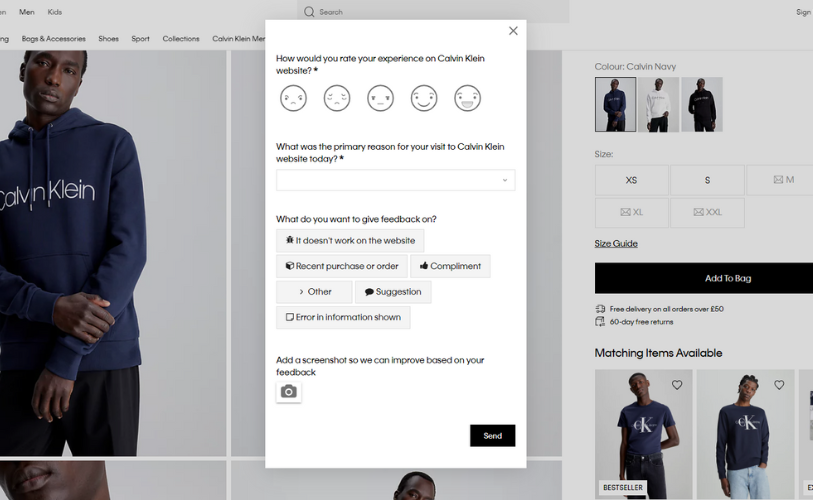Collecting customer feedback has many advantages. Forbes lists meeting customer needs, building loyalty and reducing risks and costs as some of the top reasons to stay in tune with your users’ thoughts and feelings. But exactly how do you ask your customers for feedback in a way that ensures effective insights? That’s what we’ll dive into in this article!
Sit back, grab a drink and relax while we walk you through how to ask for feedback from customers. We’ll also go through when and where for good measure.
As with all good stories, let’s start at the beginning. To set up a good strategy for collecting customer feedback you need to start with the ‘why’.
In other words, the million-dollar question is: ‘Why am I doing this?’
Well, the answer depends on you. There are many reasons why you would want to hear what your customers have to say about your business. So why don’t we dive into that topic a little deeper?
But first, a small overview. In this blog you can read about:
- Setting up goals: What do you want to achieve?
- Where should I ask for feedback?
- Examples of how to ask for feedback
Setting up goals: What do you want to achieve?
As mentioned above, there is not a simple, one-size-fits-all answer to this question. If you are a UX designer, you might collect feedback to understand how you can optimise an app flow.
If you are a conversion specialist, maybe you are looking for a way to raise conversion rates for a certain website page.
But wether your work in the product or marketing team, all customer feedback projects benefits from setting up SMART goals. This is a (rather famous) acronym that stands for:
- Specific
- Measurable
- Achievable
- Relevant
- Timely

If you are not yet familiar with SMART goals, you can find a quick and handy recap below.
Specific: Make your goals tangible
This is the ‘what’ part of your goal. Think about what you want to achieve and make it as tangible as possible. Some examples of specific customer feedback goals are:
- We want to increase our general customer satisfaction.
- We want to improve the content we have on site.
- We want to increase our conversion rate via email blasts.
Specific goals make it easier to stay focused and ensure that all actions are aimed at reaching the set target.
Measurable: How do you know that you’ve succeeded?
Making a goal measurable ensures that it can be tracked and you know when you’ve reached what you set out to do. It also allows you to keep a pulse on your progress along the way.
So: Do you want to raise your conversion rate with 10%? Make sure that you add that number into your goal!
Achievable: Shoot for the stars! But like… the stars closest to home
Listen, there is always value in having something to work towards. But no one is going to get motivated by a goal that isn’t possible to reach. Ensure that your goal is ambitious but manageable – what counts as manageable all depends on your business and where it’s currently at.
Huge, international organisations like Apple and Goolge have wildly different goals than a local scale-up, for example.
Relevant: Does your goal match the overarching team goals?
Take the bigger picture into account. If you are part of a marketing team who are currently focusing on email campaigns, it would make sense to create a goal that relates to this.
In short; make sure that your goals are aligned with the company goals.
Timely: Put a deadline on it
This point is very simple; put a time cap on your goal. It should have a clear start and end date. Creating a timebound goal:
- Makes it easier to review your success
- Ensures that the project doesn’t go on forever
There you have it! Time to set up some SMART goals and move on to the next step.
Where should I ask for feedback?
Let’s move on to the logistics of where to ask for feedback. This could refer to two things:
1. On which point of contact do you ask for feedback – i.e. website, email or app?
2. Where on your website, email or app do you ask for feedback – i.e. which page, top or bottom of your email or where in your app.
Well, as with everything else – it depends on what you want to ask. But we are happy to give you some examples of common places and tactics when asking for feedback.
1. Should I ask for feedback on my website, emails and/or app?
As you’ve probably guessed by now: it depends on the goals you’ve set for yourself. But a good rule is to ask where it’s relevant.
Let’s take a closer look at each of these channels.
- Website: As websites usually get the most traffic out of these three channels, it’s a great place to ask for general feedback, bug reporting or conduct a CSAT (customer satisfaction) survey, for example. Collecting website feedback can also help you with insights like why customers are dropping off at a certain page or what they think about specific features, like payment or delivery options.
Other typical surveys you can conduct via your website is a Customer Effort Score or Goal Completion Rate – more on this later. - Email: Sending an email with a feedback form after a completed purchase or service is standard practice in many industries. It helps you to understand how customers who have gone through your entire customer journey perceive your business. This is also why follow-up emails are a typical place to conduct NPS (Net promoter score) surveys.
Are you sending out emails with content, like newsletters or promotions? Then this is also the perfect opportunity to ask what your receivers thought of said content. You can ask something simple, for example, “How did you like this newsletter?” with a thumbs up/down. Keep it simple and keep it relevant. - App: Like websites, apps are also a good place to collect general feedback about your app specifically. It is also common to ask about any potential bugs – who better to point them out than the people who come in contact with them when using your app as intended?
Aside from this kind of general feedback, other popular surveys to conduct on apps are fake door testing (more on that later) and those related to user experience and user index.
Of course, the options are more or less limitless but these are some general examples of what kinds of surveys are common for each channel. As we said in the beginning – the most important rule to keep in mind is to keep things relevant.
2. Where on my website, app or email should I ask for feedback?
You’ve probably already figured out what we are going to say. Everyone together now: it depends on what your goals are. But let’s dive into some pointers and general rules of thumb.
Asking for feedback on your website
As we’ve already touched upon, your website is most likely the channel where you get the most visitors, making it an ideal place to ask for feedback. But websites are big.
This can make it hard to know exactly where you should show your feedback forms.
Some of the more common types of feedback surveys to conduct on a website are Customer Satisfaction (CSAT), Customer Effort Score (CES) and Goal completion rate (GCR) surveys.

An example of general feedback on Calvin Klein’s website.
- A CSAT survey is often available to all of your website visitors at all times. This is done with the help of a ‘feedback’ button, placed on either side of the screen. When clicked, a ‘pop-up’ window with your survey opens.
- A CES survey is conducted when looking for insights into how much effort it takes your visitor to conclude a certain task. Like completing a purchase or going through a flow. It’s usually done to improve the overall user experience.
As might be expected, this kind of survey should be deployed on the page where the task was completed. - GCR surveys are great for websites where a successful visit isn’t easily measured with a purchase or conversion. An example of this is insurance agencies or governmental organisations. They both get a lot of traffic on their website from people who might be searching for specific information. But how do you know if your visitors found what they were looking for? In this example, a GCR survey can indicate if the content on your website is relevant or not.
These kinds of feedback forms can, for example, effectively be deployed on the users’ exit intent. This means that the form pops up when they are about to close the window or tab, with a question asking ’Did you find what your were looking for?’ or something along those lines.
Of course, these are only some examples. You might want to deploy a survey during the checkout, after a blog article or on your search pages. It’s all up to you!
With the help of feedback software, like Mopinion, you can create forms with triggers and conditions. This allows you to specify which pages you want your forms to be visible on, to whom and when they should be activated.
Want to test it out for yourself? Check out our 14-day free trial!
Asking for feedback on your app
It’s common to have some kind of feedback form available at all times on your app. You would usually collect general feedback, allow visitors to report bugs and keep track of customer satisfaction. NPS questions asking “How likely are you to recommend this app to friends and family?” are also common.

An example of general feedback in the DHL app.
The form can often be found via a feedback button, the menu or a conversational survey. The latter one works similarly to a chatbot but with pre-determined answers and question routing.
As mentioned previously, fake door testing is also common in apps. This essentially means that you display a shell of a feature. When people click it, they will get a message saying something like “Sorry, this feature is not yet live, but we’d love to hear your thoughts about it.” A feedback form is then shown to the user with questions about their perceived importance of this particular feature. This is done to determine how wanted a certain feature is before you spend money and time actually building it.
Asking for feedback via email
If you are writing a newsletter, or any other email filled with content, putting a question at the end asking for how the reader liked the newsletter is standard practice. It allows you to gauge if your content is resonating with your audience.
Now you might be thinking: “But how do I know what they did and didn’t like?”

An example of a NPS survey after a delivery from Dutch grocery store, Albert Heijn.
With the help of feedback software, you can include a widget at the end of your email with the question “How did you enjoy the articles in this newsletter?” and a thumbs up/down. When clicking on one of the thumbs, a new tab opens with an open follow-up question for the reader. This allows you to dive deeper into the readers’ feelings and it gives you actionable insights into what you might need to change.
Using a widget also works great for a follow-up email after a completed service or purchase.
Examples of how to ask for feedback
We’ve gone through how to set goals and where you should display your surveys. But what better way to gain inspiration than looking at some actual feedback forms from leading brands? We’ve sprinkled some throughout this blog, but we’re not done yet! Hold your breath, we’re diving straight in.
Website: Allianz – Goal Completion Rate example
Allianz is an insurance agency, and as we already mentioned, this industry deals with a lot of information. People might visit their page to look up prices, policys or how certain insurances work. Not every visit will end with a conversion, making a GCR survey a great way of measuring how well their website is performing.

This is a form on their Dutch website, saying: ‘Did you find everything you were looking for on this page?’ with the options ‘yes’ or ‘no’.
The form is shown when the visitor is about to leave the page.
App: Vodafone Ireland – Fake Door Testing
In this fake door testing survey, telecommunications company Vodafone, is collecting feedback about what parts of a certain feature would be interesting for their users.

This helps them decide how to develop their app and avoid creating a wanted feature without the needed functionality.
Email: Beerwulf – Content feedback
In this email, beer distributor, Beerwulf is asking their customers what they thought about the email they have sent out.

It helps the company gauge what kind of products their target audience is interested in, making it possible for them to send out more tailored and relevant marketing materials.
Ready to start collecting feedback?
You’ve come to the right place! Mopinion is the #1 feedback software for web, app and email. And you can do it all from one convenient, user-friendly platform. From form creation with detailed question routing to deployment and analytics – right at your fingertips.
Wanna see more? Book a demo to have a chat about your specific feedback needs or try the Mopinion software yourself with a 14-day free trial.
Ready to see Mopinion in action?
Want to learn more about Mopinion’s all-in-1 user feedback platform? Don’t be shy and take our software for a spin! Do you prefer it a bit more personal? Just book a demo. One of our feedback pro’s will guide you through the software and answer any questions you may have.







